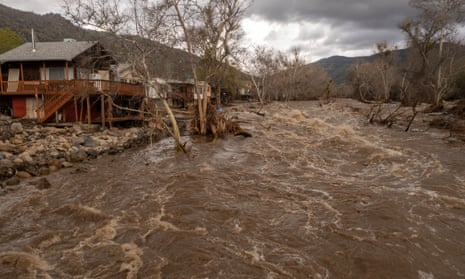The choice in the new IPCC report is stark: what we do in the next few years will determine our fate for millennia

A flash flood on the Tule River in Springville, California, earlier this month. Photograph: David McNew/Getty Images
After a 10,000-year journey, human civilisation has reached a climate crossroads: what we do in the next few years will determine our fate for millennia.
That choice is laid bare in the landmark report published on Monday by the Intergovernmental Panel on Climate Change (IPCC), assembled by the world’s foremost climate experts and approved by all the world’s governments. The next update will be around 2030 – by that time the most critical choices will have been made.
The report is clear what is at stake – everything: “There is a rapidly closing window of opportunity to secure a liveable and sustainable future for all.”
“The choices and actions implemented in this decade [ie by 2030] will have impacts now and for thousands of years,” it says. The climate crisis is already taking away lives and livelihoods across the world, and the report says the future effects will be even worse than was thought: “For any given future warming level, many climate-related risks are higher than [previously] assessed.”
“Continued emissions will further affect all major climate system components, and many changes will be irreversible on centennial to millennial time scales,” it says. To follow the path of least suffering – limiting global temperature rise to 1.5C – greenhouse gas emissions must peak “at the latest before 2025”, the report says, followed by “deep global reductions”. Yet in 2022, global emissions rose again to set a new record.
The 1.5C goal appears virtually out of reach, the IPCC says: “In the near-term, global warming is more likely than not to reach 1.5C even under a very low emission scenario.” A huge ramping up of work to protect people will therefore be needed. For example, “extreme sea level events” expected once a century today will strike at least once a year by 2100 in half of all monitored locations.
However, the faster emissions are cut, the better it will be for billions of people: “Adverse impacts and related losses and damages from climate change will escalate with every increment of global warming.” Every tonne of CO2 emissions prevented also reduces the risk of true catastrophe: “Abrupt and/or irreversible changes in the climate system, including changes triggered when tipping points are reached.”
The report presents the choice humanity faces in stark terms, made all the more chilling by the fact this is the compromise language agreed by all the world nations – many would go further if speaking alone. But it also presents the signposts to the path the world should and could take to secure that liveable future.
Amid the maze of detail set out in the thousands of pages of supporting documents, three of these signposts stand tallest. First is that the climate crisis is fundamentally a crisis of injustice: “The 10% of households with the highest per capita emissions contribute 34-45% of global consumption-based emissions, while the bottom 50% contribute 13-15%.” The climate emergency cannot end without addressing the inequalities of income and gender for the simple reason that “social trust” is required for “transformative change”.
The second signpost is that any new fossil fuel developments are utterly incompatible with the net zero emissions required. “Projected CO2 emissions from existing fossil fuel infrastructure without additional abatement would exceed the remaining carbon budget for 1.5C,” the report says.
Put plainly, that means the oil, gas and coal projects already in operation will blow our chance of limiting heating to 1.5C, unless some are shut down earlyor fitted with carbon capture technology that is yet to be proven to work at scale.
The third signpost points to the technology and finance that we need: “Feasible, effective, and low-cost options for [emissions cutting] and adaptation are already available.” Solar and wind power, energy efficiency, cuts in methane emissions and halting the destruction of forests are the key ones.
The report does not shy away from the daunting scale of the choices we need to make: “The systemic change required to achieve rapid and deep emissions reductions and transformative adaptation to climate change is unprecedented in terms of scale [and] near-term actions involve high up-front investments.”
The money is key but, the report says, “there is sufficient global capital to close the global investment gaps” if barriers to the redirection of financial flows are overcome. Furthermore, it says, the costs of climate action are clearly lower than the damages climate chaos will cause.
But there is also a gaping climate policy gap, between what is in place and what is needed: “Without a strengthening of policies, global warming of 3.2C is projected by 2100.” That is the “highway to hell”.
Three decades of IPCC warnings, mostly ignored, have brought us to the climate crossroads. As we stand there, perhaps this is the simplest way to state the choice set out by the IPCC for the world’s political and corporate leaders: what price a “sustainable and liveable future for all”?

Leave A Comment